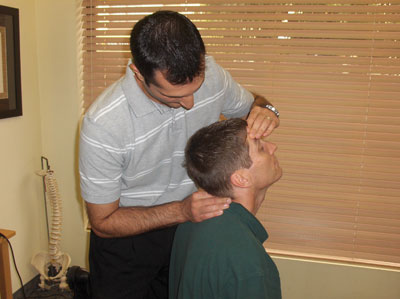

Interexaminer Reliability of Seated Motion Palpation
for the Stiffest Spinal SiteThis section is compiled by Frank M. Painter, D.C.
Send all comments or additions to: Frankp@chiro.org




FROM: J Manipulative Physiol Ther. 2018 (Sep); 41 (7): 571–579 ~ FULL TEXT
Kelly Holt, PhD, David Russell, DC, Robert Cooperstein, MA, DC, Morgan Young, DC, Matthew Sherson, DC, Heidi Haavik, DC, PhD
Center for Chiropractic Research,
New Zealand College of Chiropractic,
Aukland, New Zealand.
OBJECTIVES: The purpose of this study was to assess the interexaminer reliability of palpation for stiffness in the cervical, thoracic, and lumbar spinal regions.
METHODS: In this secondary data analysis, data from 70 patients from a chiropractic college outpatient clinic were analyzed. Two doctors of chiropractic palpated for the stiffest site within each spinal region. Each were asked to select the stiffest segment and to rate their confidence in their palpation findings. Reliability between examiners was calculated as Median Absolute Examiner Differences (MedianAED) and data dispersion as Median Absolute Deviation (MAD). Interquartile analysis of the paired examiner differences was performed.
RESULTS: In total, 210 paired observations were analyzed. Nonparametric data precluded reliability determination using intraclass correlation. Findings included lumbar MedianAED = 0.5 vertebral equivalents (VE), thoracic = 1.7 VE, and cervical = 1.4 VE. For the combined dataset, the findings were MedianAED = 1.1 VE; MAD was lowest in the lumbar spine (0.3 VE) and highest in thoracic spine (1.4 VE), and for the combined dataset, MAD = 1.1 VE. Examiners agreed on the segment or the motion segment containing the stiffest site in 54% of the observations.
There are more articles like this @ our:
CHIROPRACTIC SUBLUXATION PageCONCLUSIONS: Interexaminer reliability for palpation was good between 2 clinicians for the stiffest site in each region of the spine and in the combined dataset. This is consistent with previous studies of motion palpation using continuous analysis.
KEYWORDS: Observer Variation; Palpation; Reproducibility of Results; Spine

Return to SPINAL PALPATION
Return to LOCATING SUBLUXATIONS
Since 1-11-2019


| Home Page | Visit Our Sponsors | Become a Sponsor |
Please read our DISCLAIMER |
